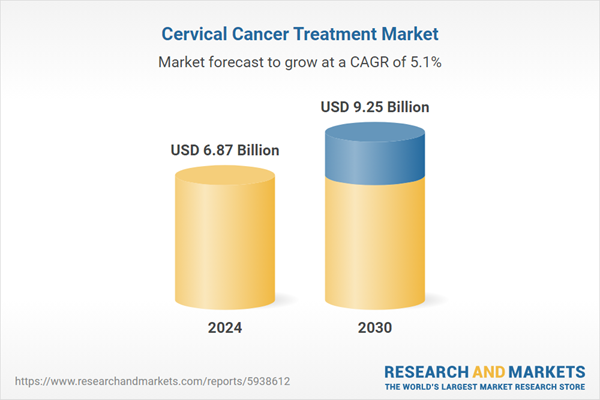Free Webex Call
Global Cervical Cancer Treatment Market was valued at USD 6.87 billion in 2024 and is expected to reach USD 9.25 billion by 2030 with a CAGR of 5.08% during the forecast period. The Global Cervical Cancer Treatment Market has witnessed significant growth and evolution in recent years, driven by a combination of factors such as rising cervical cancer incidence, advancements in treatment modalities, and increased awareness and screening initiatives. Cervical cancer is a major global health concern, with a substantial burden of disease in many regions. As a result, the market for cervical cancer treatment has expanded to meet the growing demand for effective therapies. Speak directly to the analyst to clarify any post sales queries you may have.
10% Free customizationThis report comes with 10% free customization, enabling you to add data that meets your specific business needs.
Key Market Drivers
Advancements in Medical Technology
Advancements in medical technology have played a pivotal role in boosting the Global Cervical Cancer Treatment Market, revolutionizing the way healthcare professionals diagnose, treat, and manage cervical cancer. These technological breakthroughs have not only improved patient outcomes but also enhanced the overall efficiency and effectiveness of healthcare delivery in the context of cervical cancer.One of the most notable advancements is the introduction of minimally invasive surgical techniques, such as laparoscopy and robotic-assisted surgery, which have transformed the landscape of cervical cancer treatment. These approaches offer numerous benefits, including smaller incisions, reduced post-operative pain, shorter hospital stays, and faster patient recovery. Patients now experience less trauma, scarring, and overall discomfort, which has made cervical cancer surgery a more accessible and patient-friendly option.
Targeted therapies and immunotherapies represent another remarkable breakthrough in the treatment of cervical cancer. Targeted therapies like bevacizumab have the ability to selectively target specific molecules or receptors on cancer cells, minimizing damage to healthy tissues and reducing the side effects often associated with traditional chemotherapy. This approach offers patients a more tailored and less toxic treatment option.
Immunotherapies, such as immune checkpoint inhibitors, have shown significant promise in the treatment of advanced cervical cancer. By enhancing the body's own immune system to recognize and attack cancer cells, immunotherapies have the potential to extend the lives of patients with limited treatment options. These treatments represent a paradigm shift in the management of cervical cancer, offering hope to those facing more advanced stages of the disease.
In addition to these specific treatment modalities, advancements in medical imaging technology have enhanced the accuracy of cervical cancer diagnosis and staging. High-resolution imaging techniques, such as magnetic resonance imaging (MRI) and positron emission tomography-computed tomography (PET-CT), enable healthcare professionals to assess the extent of the disease with greater precision, allowing for better treatment planning.
Key Market Challenges
Healthcare Disparities and Access to Care
Cervical cancer, a preventable and treatable disease, continues to be a major global health challenge, primarily due to healthcare disparities and limited access to care. Despite remarkable advancements in medical technology and treatment options, the burden of cervical cancer is disproportionately higher in regions with inadequate healthcare infrastructure and socioeconomic disparities. This ongoing issue hinders the progress of the global cervical cancer treatment market.In many low and middle-income countries, healthcare disparities are a glaring reality. Factors such as insufficient healthcare facilities, shortages of trained healthcare professionals, and inadequate financial resources often stand in the way of women seeking timely and appropriate cervical cancer care. Access to cervical cancer screening, vaccination against human papillomavirus (HPV), and effective treatment is a privilege enjoyed by only a fraction of the population. As a result, many women in these regions are denied the opportunity for early diagnosis, essential treatment, and ultimately, better outcomes.
The lack of access to quality healthcare contributes to late-stage cervical cancer diagnoses, which are typically associated with lower survival rates and more aggressive treatment regimens. This results in a higher demand for costly, advanced therapies, further exacerbating the financial burden on patients and healthcare systems. Additionally, late-stage cervical cancer cases often require extensive resources, including specialized medical equipment and trained personnel, putting additional strain on already fragile healthcare infrastructures.
Key Market Trends
Innovative Treatment Approaches
Innovative treatment approaches are playing a pivotal role in boosting the Global Cervical Cancer Treatment Market. While traditional modalities such as surgery, chemotherapy, and radiation therapy have been cornerstones of cervical cancer treatment, the emergence of novel therapeutic options represents a significant breakthrough in the field. These innovative treatments offer improved efficacy, reduced side effects, and new hope for patients facing this devastating disease.One of the most promising trends in cervical cancer treatment is the development of targeted therapies. These treatments are designed to specifically interfere with molecular pathways responsible for the growth of cancer cells. By targeting the unique features of cancer cells, targeted therapies can disrupt the progression of the disease while sparing healthy tissues. Bevacizumab, an anti-angiogenic therapy, is one such example used to inhibit blood vessel formation within the tumor, effectively starving the cancer cells and reducing tumor growth. Targeted therapies not only enhance treatment outcomes but also offer a less toxic and more precise alternative to traditional chemotherapy.
Immunotherapies have also made a significant impact on the cervical cancer treatment market. Immune checkpoint inhibitors, for instance, are a class of immunotherapies that have demonstrated remarkable results in clinical trials. By blocking specific proteins that inhibit the immune system's response, these therapies empower the patient's own immune system to recognize and attack cervical cancer cells. This innovative approach is particularly promising for patients with advanced or recurrent cervical cancer and offers new avenues for treatment.
Key Market Players
- F. Hoffmann-LA Roche AG
- Merck & Co., Inc
- GlaxoSmithKline PLC
- Allergan PLC
- Pfizer, Inc.
- Biocon Ltd.
- Bristol-Myers Squibb
- AstraZeneca PLC
- Eli Lilly & Co.
- Johnson & Johnson Services, Inc.
Report Scope:
In this report, the Global Cervical Cancer Treatment Market has been segmented into the following categories, in addition to the industry trends which have also been detailed below:Cervical Cancer Treatment Market, By Type:
- Squamous cell carcinoma
- Adenocarcinoma
- Adenosquamous carcinoma
Cervical Cancer Treatment Market, By Product:
- Prevention
- Treatment
Cervical Cancer Treatment Market, By Distribution Channel:
- Hospital Pharmacies
- Retail Pharmacies
- Online Pharmacies
Cervical Cancer Treatment Market, By Region:
- North America
- United States
- Canada
- Mexico
- Europe
- France
- United Kingdom
- Italy
- Germany
- Spain
- Asia-Pacific
- China
- India
- Japan
- Australia
- South Korea
- South America
- Brazil
- Argentina
- Colombia
- Middle East & Africa
- South Africa
- Saudi Arabia
- UAE
Competitive Landscape
Company Profiles: Detailed analysis of the major companies present in the Global Cervical Cancer Treatment Market.Available Customizations:
With the given market data, the publisher offers customizations according to a company's specific needs. The following customization options are available for the report.Company Information
- Detailed analysis and profiling of additional market players (up to five).
This product will be delivered within 1-3 business days.
Table of Contents
1. Product Overview
2. Research Methodology
3. Executive Summary
4. Global Cervical Cancer Treatment Market Outlook
5. Asia Pacific Cervical Cancer Treatment Market Outlook
6. Europe Cervical Cancer Treatment Market Outlook
7. North America Cervical Cancer Treatment Market Outlook
8. South America Cervical Cancer Treatment Market Outlook
9. Middle East and Africa Cervical Cancer Treatment Market Outlook
10. Market Dynamics
11. Market Trends & Developments
13. Porter’s Five Forces Analysis
14. Competitive Landscape
Table Information
| Report Attribute | Details |
|---|---|
| No. of Pages | 185 |
| Published | March 2025 |
| Forecast Period | 2024 - 2030 |
| Estimated Market Value ( USD | $ 6.87 Billion |
| Forecasted Market Value ( USD | $ 9.25 Billion |
| Compound Annual Growth Rate | 5.0% |
| Regions Covered | Global |
| No. of Companies Mentioned | 10 |









